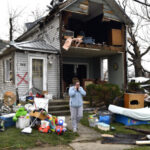As wildfires seemingly increase in frequency and severity of insured losses year after year, insurers are devising fire prevention methods to protect their client’s properties — including hiring private firefighting specialists.
New Jersey-based Chubb Corp. began offering free fire protection to its clients in 13 Western states in March 2008. Already, 11,000 homeowners have signed up, more than one-third of those in wealthy and fire-prone enclaves like Lake Tahoe and California’s Marin County. The company plans to expand the service to other states before the start of next fire season.
Additionally, Chubb hired Montana-based Wildfire Defense Systems Inc. to protect homes with a replacement value of $1 million or more. And the company is now subcontracting a pool of 50 fire engines throughout the West dedicated exclusively to policyholders.
The move toward private fire crews is in some ways a throwback to an earlier era, when homeowners in colonial times joined together to form “fire clubs” that protected members’ homes. Early fire departments were often supported by insurance companies that had a vested interest in preventing disaster.
Yet hiring private contractor firefighters is just one risk management strategy. Dan Cuccia, senior risk-management advisor for Novato, Calif.-based Fireman’s Fund Insurance Co., said his company’s firefighting program instead “is based on the philosophy of prevention.” When property is in wildfire danger, the company offers emergency response capability and provides an additional layer of protection for its clientele. The emphasis, Cuccia said, is on “prevention” and to be “proactive.”
“Risk managers go into the field to provide a detailed inspection of the home,” he explained. “During this inspection, they focus on the wildfire sustainability of the home and make their assessments.” Property owners are given information to help them mitigate fires before they spark.
Wildfire experts say more homes are at risk of wildfires today because increasing numbers of people are constructing homes in areas referred to as the Wildland Urban Interface. This is where construction and wildlands intersect, placing properties at a higher risk for natural disasters.
“Urban sprawl continues, which creates conditions and heightens the concern of the insurer of wildfire risk,” Cuccia said. Insurers must “feel comfortable with the risks that we assume, and to mitigate that exposure is important,” he added.
Consequently, Fireman’s Fund advocates and supports methods of protection, Cuccia said. “We get to the nuts and bolts of what truly saves a home. We have amazing experience and a very positive history, especially with last year’s fire season. … If we can assist the customer in (prevention and mitigation), we will,” he said.
For American International Group Inc. (AIG), wildfire prevention entails a two-stage process, said Peter Tulupman, public relations manager. During the first stage, the company “looks at the home and the grounds to see if there is something that the homeowner needs to do before wildfire season,” he explained. “Beginning in wildfire season, we have 12 trucks that are floating around. Fire break systems work with them to perform pre-season assessments of the insured.”
If a home seems to be in risk of a wildfire, AIG uses an environmentally friendly chemical called Phos-chek as a shield against fires. “We spray down the perimeter of the home, which should last throughout the wildfire season,” Tulupman said.
Stage two is only factored into the equation when a wildfire burns through one of the protected areas. “If there is a wildfire raging, we have GPS technology to look and see where the wildfire is at, where it is going, the wind factors, etc.,” Tulupman said. The company assesses, “Do we need to visit homes that are potentially in jeopardy? If so we go to those locations and spray Phos-chek,” which also can be used to extinguish fires, he explained.
AIG started its Wildfire Protection Unit in 2005, offering free fire protection services to four counties in California (San Diego County, Orange County, Los Angeles County, the San Francisco Bay), and one in Colorado (Aspen). The unit services about 200 ZIP codes throughout those areas.
“Wealthy people want to live in beautiful places, and beautiful places are prone to natural disasters,” Tulupman said, noting homes being constructed in the WUI.
While Wildfire Protection Unit services are free, homeowners must sign up. Since January 2007, enrollment has more than doubled from 1,200 to nearly 3,200. Also, since January, AIG expanded the ZIP codes included in the services to just fewer than 200.
“We recommend that everyone sign up for this service who lives within the five zones,” Tulupman said. He noted the company sees “spikes” in program enrollment “whenever wildfires are going on.” Enrollment jumped nearly 60 percent after the 2007 October California wildfires, he said.
Nevertheless, Tulupman emphasized that AIG does not try to be “a private fire service, nor would we go to a house and try to put out a fire.” “We work closely with local and national fire authorities … in concert … with no interference,” he said.
The Associated Press contributed to this article. Copyright 2008 Associated Press. All rights reserved. This material may not be published, broadcast, rewritten or redistributed.
Was this article valuable?
Here are more articles you may enjoy.

 Triple-I: Insurance Economic Drivers Outperform Overall US GDP
Triple-I: Insurance Economic Drivers Outperform Overall US GDP  Gallagher: Global Insured Natural Disaster Claims Again Dominated by Severe U.S. Storms
Gallagher: Global Insured Natural Disaster Claims Again Dominated by Severe U.S. Storms  Hawaiian Electric Hits 40-Year Low Ahead of Maui Fire Report
Hawaiian Electric Hits 40-Year Low Ahead of Maui Fire Report  Microsoft, Beset by Hacks, Grapples With Problem Years in the Making
Microsoft, Beset by Hacks, Grapples With Problem Years in the Making 